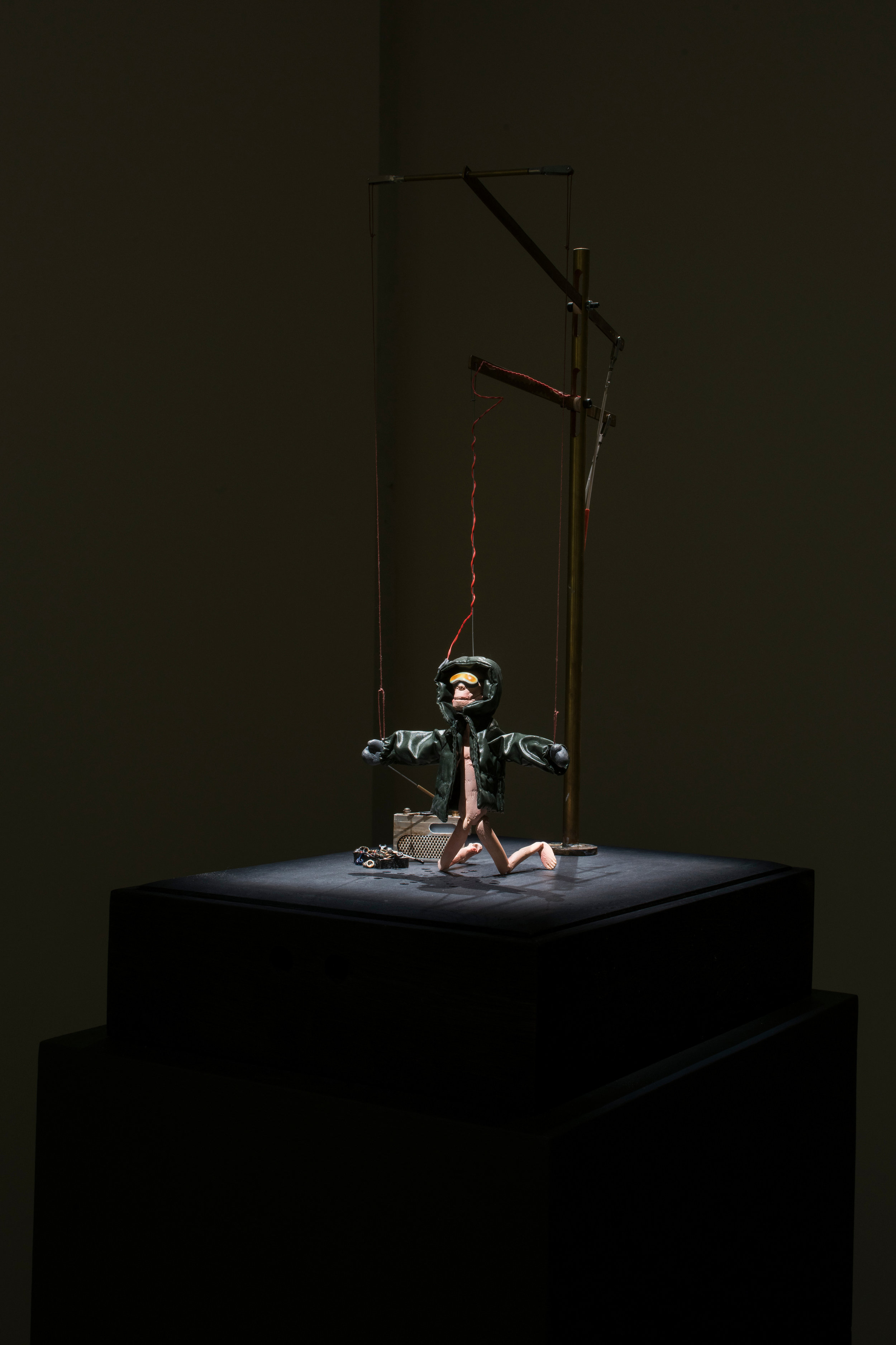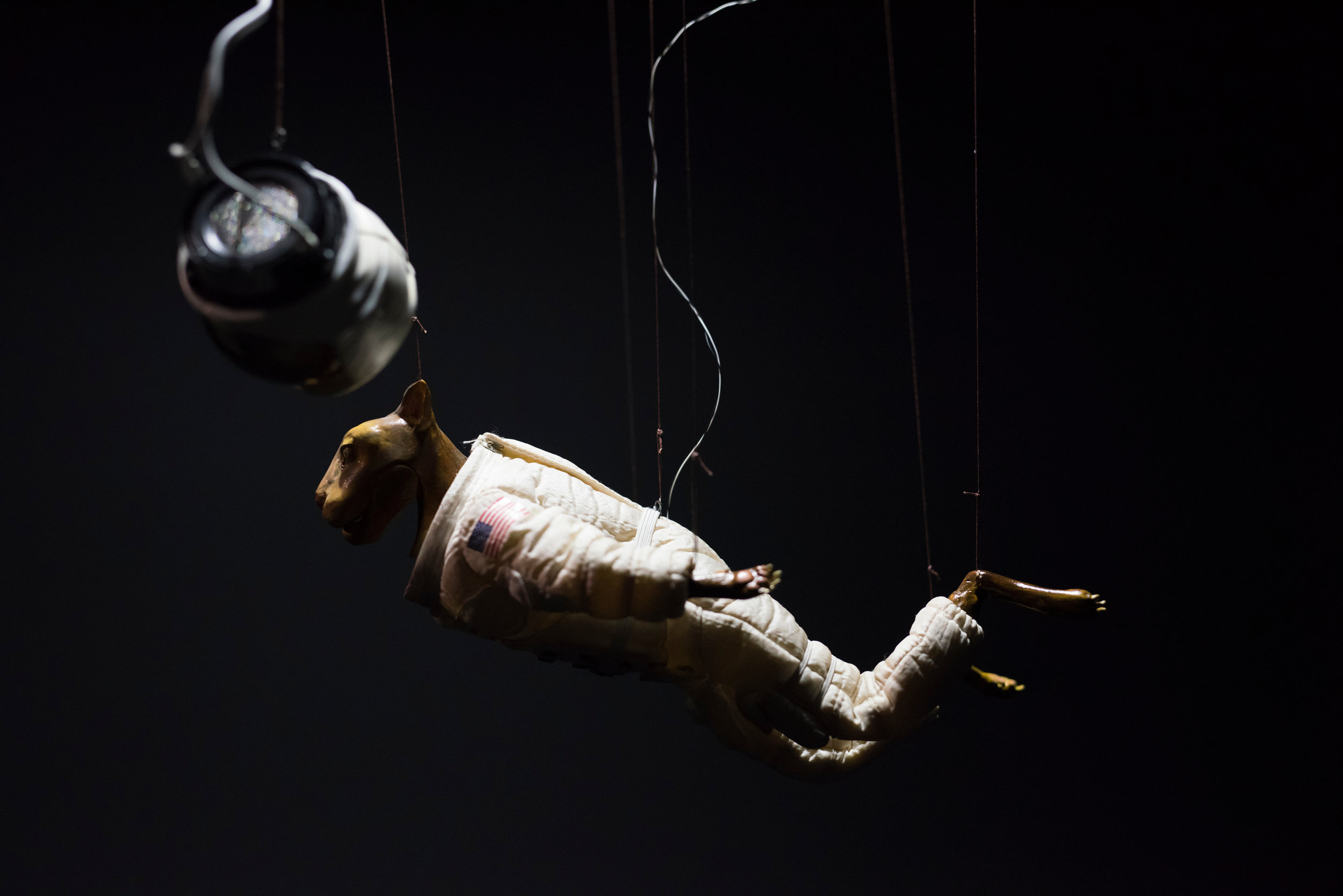....
Né en 1972 au Havre, Nicolas Darrot vit et travaille à Paris. Après une première formation à l’Ecole d’architecture de Grenoble, il entre à l’Ecole nationale supérieure des Beaux-Arts de Paris. En 1998, une fois son diplôme obtenu, Nicolas Darrot travaille quelque temps dans le monde cinématographique au sein d’une équipe chargée des effets spéciaux. Il y apprend l’art de transformer un corps, un objet en animatronique, autrement dit à l’animer à distance, à le robotiser.
L’oeuvre plurielle de Nicolas Darrot déclinée en sculptures, installations, objets hybrides et automatisés est empreinte de l’univers des cabinets de curiosités, ainsi que du monde du théâtre, et en particulier de celui des marionnettes. Inventeur de génie, l’artiste emporte le regardeur dans un univers à la lisère des rêves, ou la poétique de l’art s’immisce au cœur d’une démarche, qui à tâtons, va sonder les tréfonds de l’imaginaire. Bâtisseur céleste, Nicolas Darrot nous entraîne dans un ballet mécanique, duquel s’évapore une beauté complexe.
Dans un univers fabuliste analogue à La Fontaine, l’imaginaire enfantin marquant son travail, les animatroniques de Nicolas Darrot nous parlent et engagent un questionnement sur la société humaine. La force de l’artiste résidant dans sa capacité à soulever des problématiques humaines par le biais d’expérimentations très techniques. Acteurs d’un théâtre humain, ses machines plongent le spectateur dans un espace autre nous échappant, entre poésie et hétéroclisme. Un monde à la Jérôme Bosch, fantasque et futuriste.
A mi-chemin entre l’œuvre d’art et l’objet scientifique expérimental didactique, les machines de l’artiste inspirées du monde humain et animal, nous permettent également d’entamer une réflexion sur notre rapport avec le monde de l’innovation technique.[1]
S’imposant sur la scène artistique contemporaine au début des années 2000, Nicolas Darrot est en 2006 un des premiers artistes à investir le patio de La Maison rouge - Fondation Antoine de Galbert, à Paris en présentant son installation monumentale « Passage au noir ». S’ensuit de nombreuses expositions personnelles et collectives, aussi bien en France qu’à l’internationale, telles que : « Bêtes et hommes », Grande halle de la Villette (2007) ; « Félicien Marboeuf », Fondation Ricard, Paris (2009) ; « Bêtes off », La conciergerie, Paris (2012) ; «Histoires d’automates », Théâtre des Sablons, Neuilly sur Seine (2013) ; Être étonné, c’est un bonheur, Chapelle de la visitation, Thonons-les-Bains (2015) ; « Constructeurs d’absurde, bricoleurs d’utopies », Centre d’Art Contemporain, Meymac (2015) ; « Être et à voir », Collection C+J Mairet, Musée d’art moderne et contemporain de Strasbourg (2016) ; « Règne analogue », La maison rouge, Paris (2016) ; « Nuage parallèle », Fondation Claudine et Jean-Marc Salomon, Annecy-le-Vieux (2017) ; « Le Voyage à Nantes », Opéra, place Graslin et Temple du Goût, Nantes (2017) ; « A night of philosophy », Kiasma Museum of Contemporary Art, Helsinki (2017) ; « Loup y es-tu ? Bestiaire et métamorphoses », Château de Maisons, Maisons-Laffitte (2018) ; « Fête de l’Ours », Musée de la chasse et de la nature, Paris (2018) ; « The Kamigo Band – Songs for the seasons », Echigo Tsumari Triennale, Japon (2018) ; « Artistes et robots » au Grand Palais, Paris (2018).
[1] Dufrêne Thierry ; Korichi Mériam ; J. Emil Sennewald : Nicolas Darrot, Règne analogue, co-édition La Maison rouge - Fondation Antoine de Galbert, Fages éditions, Lyon, 2016. (Catalogue publié à l’occasion de l’exposition Règne analogue, présentée à La Maison rouge – Fondation Antoine de Galbert du 8 juillet au 18 septembre 2016).
..
Born in Le Havre in 1972, Nicolas Darrot lives and works in Paris. After initial training at the Ecole d’Architecture de Grenoble, he enrolled in the Ecole Nationale Supérieure des Beaux-Arts in Paris. In 1998, after graduating, Nicolas Darrot worked for a while in the film world as part of a special effects team. There he learned the art of transforming a body, an object into an animatronic creature, which is to say how to create and remote-control such a creature so that it moves in a life-like manner, to “robotize”.
Nicolas Darrot’s multifaceted work in sculpture, installations, hybrid and automated objects is imbued with the world of the cabinet of curiosities, as well as the world of the theatre, and in particular that of puppets. Inventor of genius, the artist whisks the viewer off into a world on the edge of dreams, where the poetics of art is at the heart of a process feeling its way into the depths of the imagination. A celestial builder, Nicolas Darrot leads us into a mechanical ballet, which generates a complex beauty.
In a fabulist universe similar to La Fontaine’s, a childlike imagination marking his work, the animatronics of Nicolas Darrot engage us in a questioning of human society. The strength of the artist resides in his ability to raise human issues through very technical experiments. Actors in a human theater, his machines plunge the spectator into another space that normally eludes us, between poetry and heteroclism: a world like that of Jerome Bosch, whimsical and futuristic.
Midway between the work of art and the experimental didactic scientific object, the artist’s machines inspired by the human and animal worlds also allow us to start thinking about our relationship with the world of technical innovation.[1]
Establishing himself on the contemporary art scene in the early 2000s, Nicolas Darrot was one of the first artists in 2006 to inaugurate the patio of La Maison Rouge – Antoine de Galbert Foundation in Paris by presenting his monumental installation “Passage au noir” (Passage to Black). This was followed by numerous solo and group exhibitions, both in France and internationally, including “Bêtes et Hommes” (Beasts and Humans), Grande Halle de la Villette, Paris (2007) ; “Félicien Marboeuf” , Fondation Ricard, Paris (2009) ; “Bêtes off” (Beasts Off), La Conciergerie, Paris (2012) ; “Histoires d’automates” (Automaton Stories), Théâtre des Sablons, Neuilly sur Seine (2013) ; “Être étonné, c’est un bonheur” (To Be Surprised is Happiness), Chapelle de la Visitation, Thonons-les-Bains (2015) ; “Constructeurs d’absurde, bricoleurs d’utopies” (Builders of the Absurd, DIYers of Utopia), Centre d’Art Contemporain, Meymac (2015) ; “Être et à voir” (To Be and To Be Seen), Collection C+J Mairet, Musée d’art Moderne et Contemporain de Strasbourg (2016) ; “Règne analogue” (Analogous Reign), La Maison Rouge, Paris (2016) ; “Nuage parallèle” (Parallel Cloud), Fondation Claudine et Jean-Marc Salomon, Annecy-le-Vieux (2017) ; “Le voyage à Nantes” (Journey to Nantes), Opéra, place Graslin et Temple du Goût, Nantes (2017) ; “A Night of Philosophy”, Kiasma Museum of Contemporary Art, Helsinki (2017) ; “Loup y es-tu ? Bestiaire et métamorphoses” (Cry Wolf, Bestiary and Metamorphosis, Château de Maisons, Maisons-Laffitte (2018) ; “Fête de l’Ours” (Bear Festival), Musée de la Chasse et de la Nature, Paris (2018) ; “The Kamigo Band – Songs for the seasons”, Echigo Tsumari Art Triennale, Japan (2018) ; “Artistes et robots” (Artists and Robots), Grand Palais, Paris (2018).
[1] Dufrêne Thierry ; Korichi Mériam ; J. Emil Sennewald : Nicolas Darrot, Règne analogue, co-édition La Maison rouge - Fondation Antoine de Galbert, Fages éditions, Lyon, 2016.
(Catalogue publié à l’occasion de l’exposition Règne analogue, présentée à La Maison rouge – Fondation Antoine de Galbert du 8 juillet au 18 septembre 2016).
....






















